Demolition Contractors Burlington
Best Demolition Contractor in Burlington
Receive 3 FREE Building Demolition quotes for your project today! Compare profiles, reviews, accreditations, portfolio, etc... and choose the best deal.
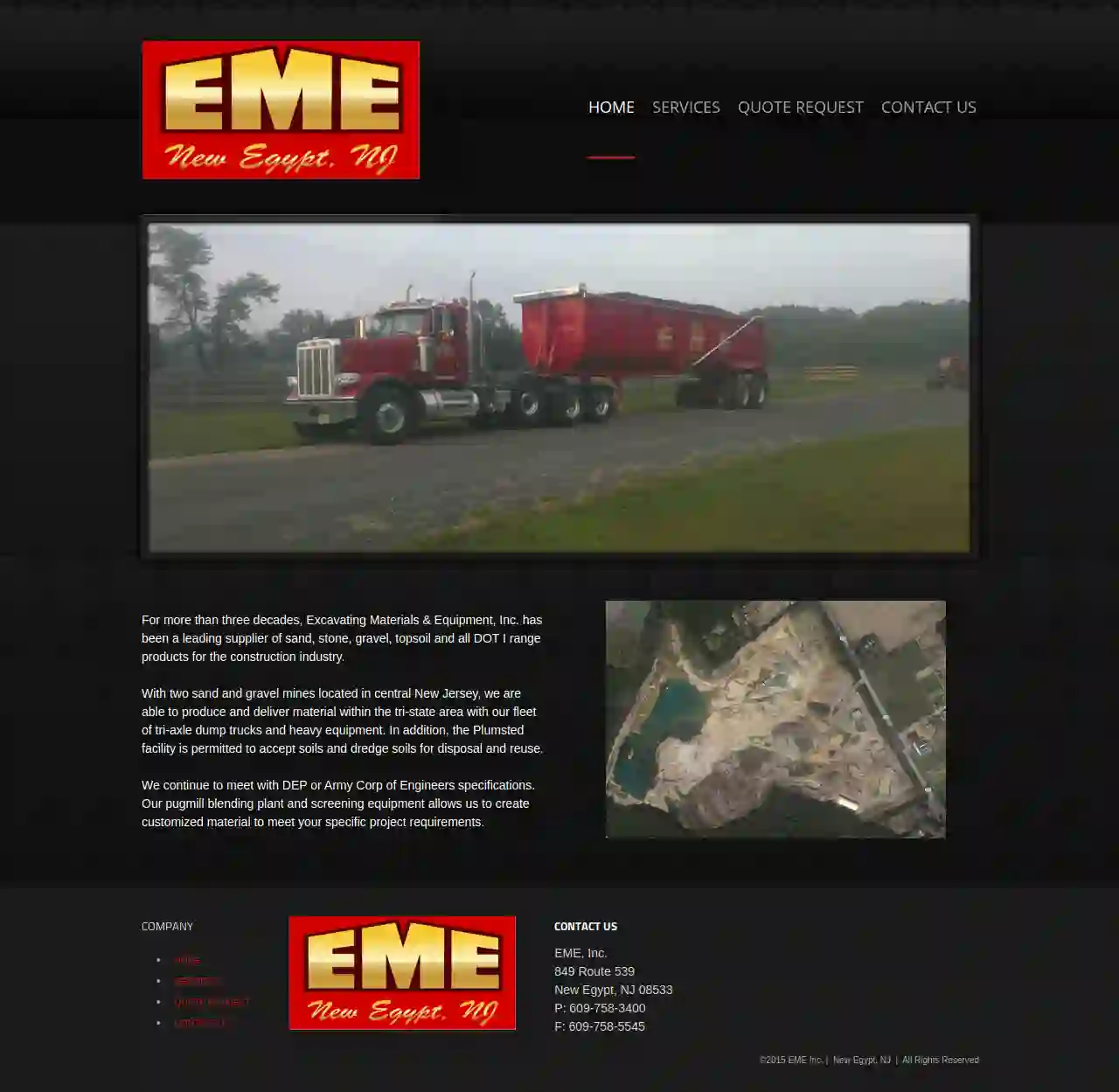
Excavating Materials & Equipment, Inc.
37 reviews849 Route 539, New Egypt, 08533, USExcavating Materials & Equipment, Inc. (EME) For over three decades, EME has been a leading supplier of sand, stone, gravel, topsoil, and DOT I range products for the construction industry in central New Jersey. We operate two sand and gravel mines, ensuring we can efficiently produce and deliver materials within the tri-state area using our fleet of tri-axle dump trucks and heavy equipment. Our commitment to quality extends beyond material supply. The Plumsted facility is permitted to accept soils and dredge soils for disposal and reuse, adhering to strict DEP and Army Corp of Engineers specifications. Our pugmill blending plant and screening equipment allow us to create customized materials tailored to your specific project requirements.
- Services
- Why Us?
- Gallery
Get Quote
Fox Contractors Corp
4.618 reviews5430 W. Ferguson Road, Fort Wayne, 46809, USWe can dig it. To get a job done right, you need to start with someone who really knows what they’re doing. That’s Fox Contractors. Decades of laying the groundwork Since 1948, we’ve been behind projects in and around Indiana that require specialized support with earthmoving and underground utilities. Our expertise can be found on jobs that range from heavy highway and public works to commercial and industrial site development. View Our Certifications Minority Business Enterprise Indiana Veteran Owned Small Business Enterprise Veteran Owned Business After more than 70 years in business, we’ve built a reputation for impeccable work that’s done on time and on budget. That, along with our fair pricing and highly skilled, safety-conscious workforce make us the first choice for project managers who are looking for a reliable partner. Our clients include DOTs, municipalities, general contractors and developers, and we have experience in the healthcare, education and environmental fields. Fox Contractors is proud to be a certified Minority Business Enterprise (MBE) and a 100% signatory contractor with the IUOE, Teamsters and Laborers’ unions. With a headquarters in Fort Wayne and a regional office near Indianapolis, Fox Contractors serves customers across the region and is prequalified with the Indiana, Michigan and Ohio Departments of Transportation. We take care of business – from the ground up. ”Fox places a high value on safety because our people are our #1 asset. We strive to minimize or eliminate hazards all together, so that all employees can work in a safe environment, without losing time. Our safety-first approach is reflected in our extensive training and education, as well as an employee safety commitment that starts from the top down.” Dallas Day, Owner, Fox Contractors Corp.
- Services
- Why Us?
- Testimonials
- Gallery
Get Quote
SJ Hauck Construction
4.882 reviewsAtlantic City, USSafer Structures Streamlined Solutions Whether you're starting a new commercial project or are getting ready to build a new house, if you have an existing structure or house on your property that needs to be removed, we are ready! Let the professionals at SJ Hauck Construction get your land ready for building again! Deep foundations are essential for ensuring the stability and safety of structures, especially in areas with challenging soil conditions or where the structure needs to resist high loads or seismic forces. Proper design and construction of deep foundations are crucial to the long-term performance and integrity of the built environment. Support of Excavation (SOE) is a crucial aspect of construction projects that involve digging below ground level. SOE systems are temporary earth-retaining structures designed to control soil movement and prevent cave-ins, ensuring the safety and stability of excavation sites.
- Services
- Why Us?
- Gallery
Get Quote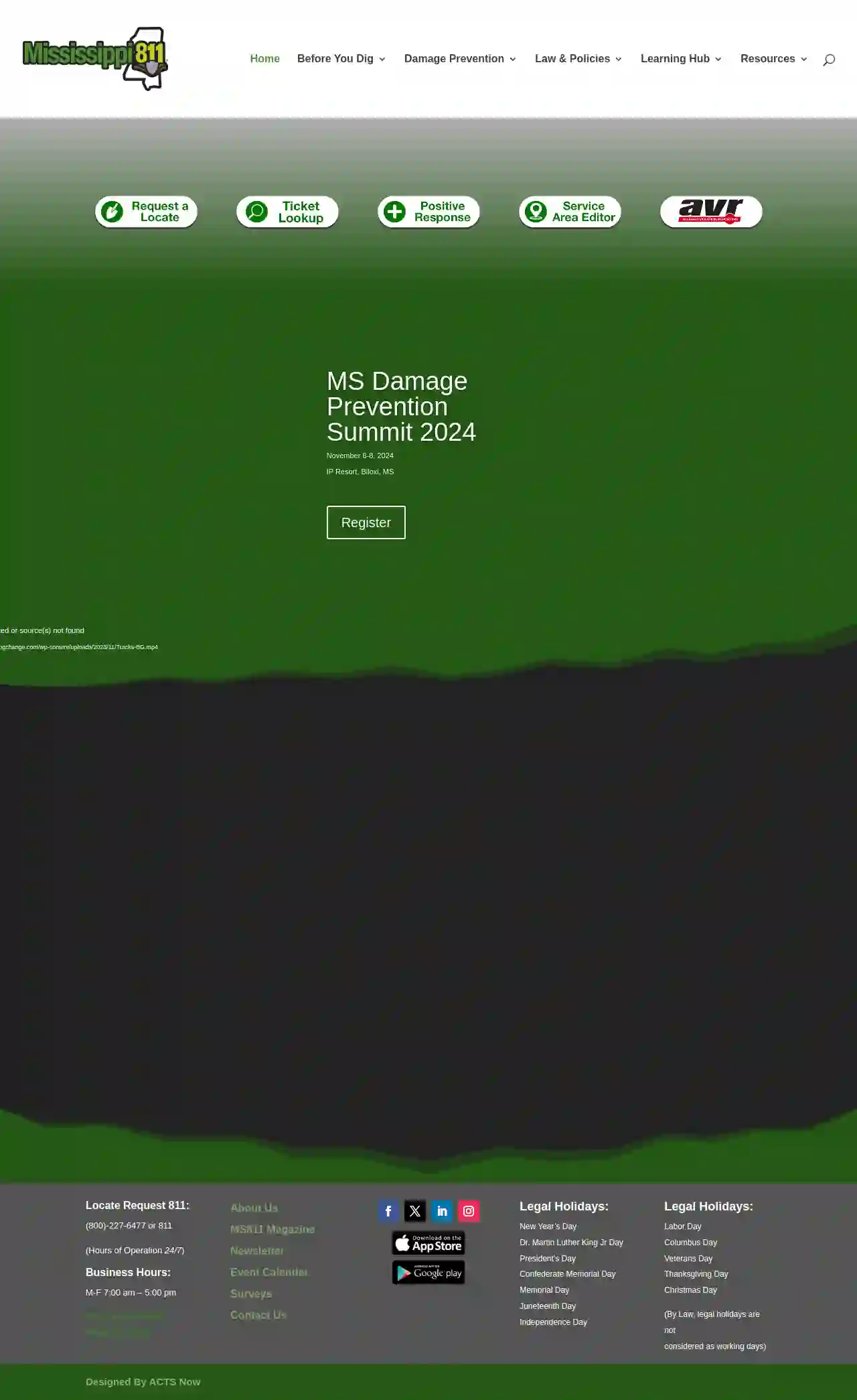
Mississippi 811, Inc.
4.823 reviews200 Country Pl Pkwy, Pearl, 39208, USAbout MS811 MS811 is a vital resource for anyone planning to dig in Mississippi. Our mission is to protect underground infrastructure and ensure the safety of excavators, homeowners, and the public. We provide a free, easy-to-use service that helps you locate underground utilities before you dig. By calling 811 or visiting our website, you can request a locate request and ensure that you are digging safely. We are committed to providing our customers with the highest level of service and support. Our team of experts is available 24/7 to answer your questions and help you navigate the process of digging safely. We also offer a variety of resources and information to help you understand the importance of damage prevention and the laws and regulations that govern excavation in Mississippi. We believe that everyone has a role to play in protecting underground infrastructure. By working together, we can prevent damage to utilities and ensure the safety of our communities.
- Services
- Why Us?
- Gallery
Get Quote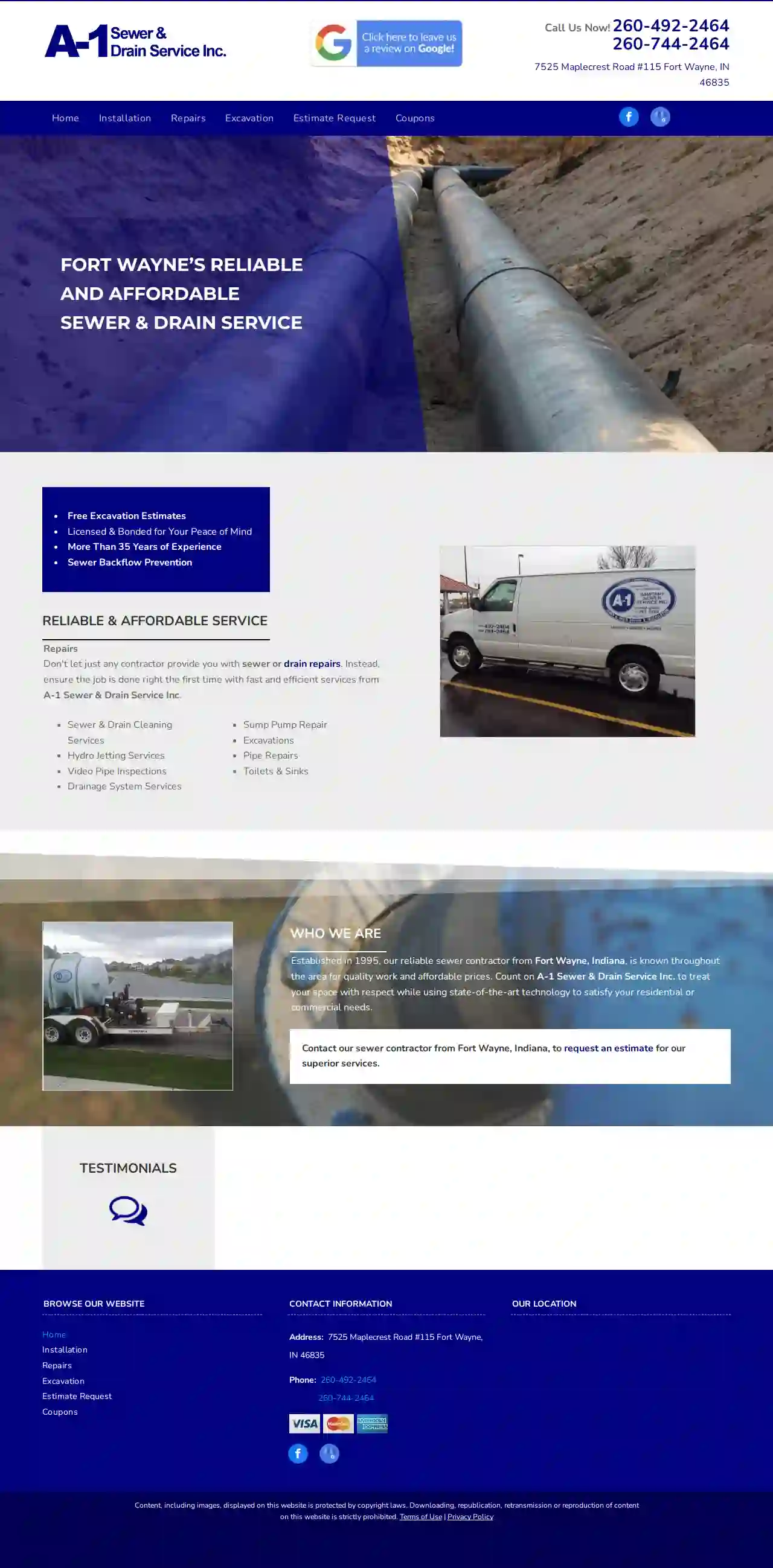
A-1 Sanitary Sewer & Drain Service
4.127 reviews7525 Maplecrest Road, #115, 7525 Maplecrest Road #115, Fort Wayne, 46835, USFORT WAYNE’S RELIABLE AND AFFORDABLE SEWER & DRAIN SERVICE Don't let just any contractor provide you with sewer or drain repairs. Instead, ensure the job is done right the first time with fast and efficient services from A-1 Sewer & Drain Service Inc. Established in 1995, our reliable sewer contractor from Fort Wayne, Indiana, is known throughout the area for quality work and affordable prices. Count on A-1 Sewer & Drain Service Inc. to treat your space with respect while using state-of-the-art technology to satisfy your residential or commercial needs. Contact our sewer contractor from Fort Wayne, Indiana, to request an estimate for our superior services.
- Services
- Why Us?
- Testimonials
- Gallery
Get Quote
Dirt Dynasty LLC
54 reviewsBridgewater, New Jersey, USWelcome to Dirt Dynasty, where our foundation is built on the very grounds we work with. Established in recent years by a team of ambitious professionals, we've quickly risen through the ranks to carve our niche in the excavation and masonry service industry. Our journey began when our founders, armed with years of invaluable experience and a vision of independence, decided it was time to stop working under others and instead, build their own legacy. Thus, Dirt Dynasty was born. At Dirt Dynasty, we specialize in a wide array of services designed to meet the diverse needs of both businesses and homeowners alike. Our expertise spans trenching, creating your dream pools and ponds, installing septic tanks, oil tank removals, and the careful demolition of structures. But our craftsmanship doesn’t end there; we also excel in constructing durable retaining walls, crafting picturesque outdoor patios, and setting up functional outdoor kitchens that become the heart of your backyard gatherings. Understanding the needs of our clients extends beyond just the services we offer. We also provide material deliveries including clean stone, fill, mulch, pond rocks, and more, ensuring that your projects have the high-quality materials they require, delivered right to your doorstep. What sets Dirt Dynasty apart is not just our comprehensive service offerings, but our unwavering commitment to satisfaction. We believe in building relationships that go beyond the transaction. Every project we undertake is a testament to our dedication to excellence, attention to detail, and the respect we hold for your vision and space. We strive to not only meet your expectations but exceed them, ensuring that every interaction with us is as seamless and positive as possible. Even if you don’t have an immediate need for our services, we invite you to reach out. Let's lay the groundwork for a future project, discuss your ideas, or simply get to know each other better. At Dirt Dynasty, we believe in fostering connections that might not bear immediate fruit but will grow into strong, supportive relationships over time. Thank you for considering Dirt Dynasty for your excavation and masonry needs. We look forward to the opportunity to work with you and to add your project to the legacy of our dynasty.
- Services
- Why Us?
- Gallery
Get Quote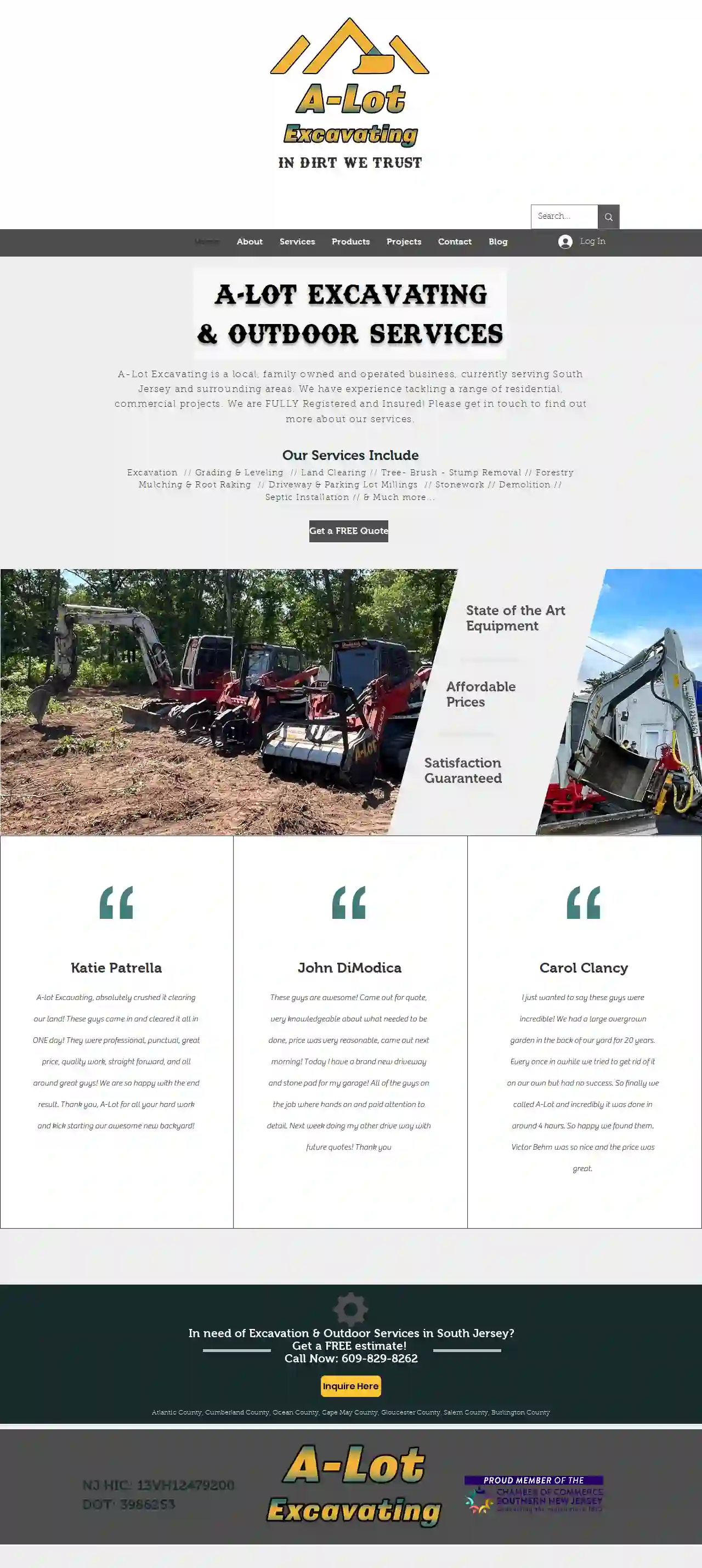
A-Lot Excavating
4.713 reviewsAtlantic City, USA-Lot Excavating & Outdoor Services A-Lot Excavating is a local, family owned and operated business, currently serving South Jersey and surrounding areas. We have experience tackling a range of residential, commercial projects. We are FULLY Registered and Insured! Please get in touch to find out more about our services. Our Services Include Excavation // Grading & Leveling // Land Clearing // Tree- Brush - Stump Removal // Forestry Mulching & Root Raking // Driveway & Parking Lot Millings // Stonework // Demolition // Septic Installation // & Much more... Get a FREE Quote State of the Art Equipment // Affordable Prices // Satisfaction Guaranteed
- Services
- Why Us?
- Testimonials
- Gallery
Get Quote
Next Level Excavation
54 reviewsEgg Harbor Township, USFamily owned and operated Bring your projects to the Next Level Who we are Doug is the owner and operator of Next Level Excavation. Doug has over 18 years experience in all types of excavation. From small residential projects to large commercial projects we have you covered! Safety is our standard. All employees are O.S.H.A. Certified Fully licensed and insured Over 18 years of experience Services Excavator and skid steer services Brush removal Bulk trash hauling Concrete removal Drainage systems Fence/deck/shed demolition and removal Trenching of any kind Stone driveways Grading Dump trailer rental Material hauling Much more… Prompt and Reliable Satisfaction Guaranteed
- Services
- Why Us?
- Our Team
- Gallery
Get Quote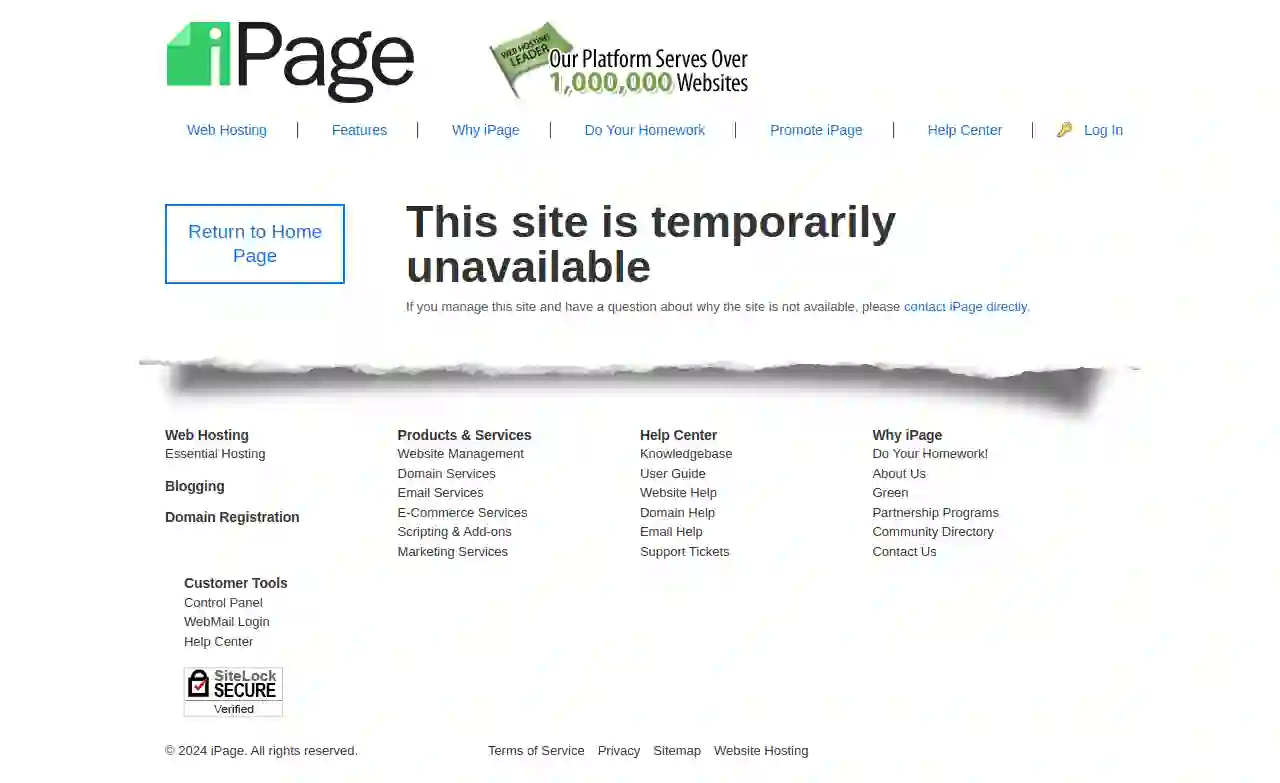
Founders Contracting - Directional Drilling Company
Wayne, USiPage is a leading provider of web hosting and domain name services for both individuals and businesses. We offer a wide range of hosting plans to suit your needs, from basic shared hosting to powerful VPS and dedicated servers. Our services are designed to help you build and grow your online presence, with features like easy-to-use website builders, one-click installs for popular applications, and 24/7 customer support. We are committed to providing our customers with the best possible experience, and we are constantly innovating to improve our services. We are also proud to be a green company, committed to reducing our environmental impact. We believe in providing our customers with the best possible value, and we offer a variety of affordable hosting plans to fit your budget. We are confident that you will be satisfied with our services, and we encourage you to try us out today.
- Services
- Why Us?
- Gallery
Get Quote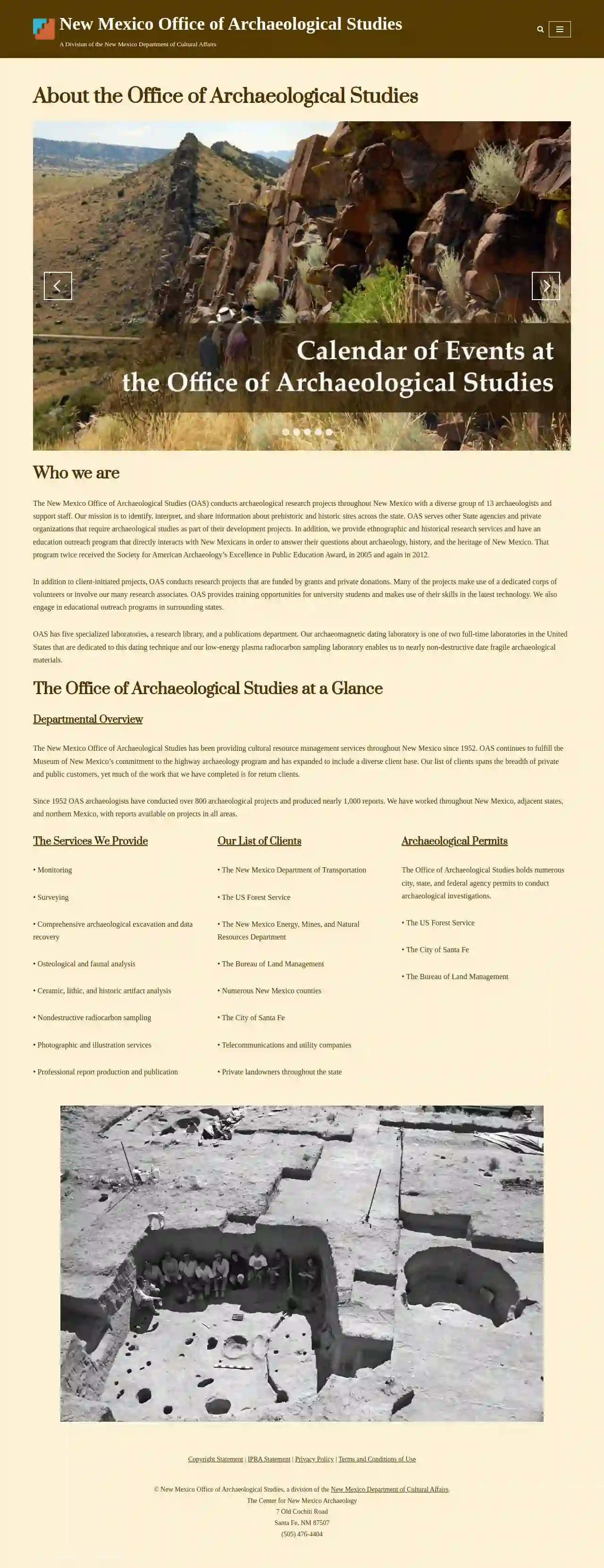
The New Mexico Office of Archaeological Studies
4.312 reviews7 Old Cochiti Road, Santa Fe, 87507, USAbout the Office of Archaeological Studies The New Mexico Office of Archaeological Studies (OAS) conducts archaeological research projects throughout New Mexico with a diverse group of 13 archaeologists and support staff. Our mission is to identify, interpret, and share information about prehistoric and historic sites across the state. OAS serves other State agencies and private organizations that require archaeological studies as part of their development projects. In addition, we provide ethnographic and historical research services and have an education outreach program that directly interacts with New Mexicans in order to answer their questions about archaeology, history, and the heritage of New Mexico. That program twice received the Society for American Archaeology’s Excellence in Public Education Award, in 2005 and again in 2012. In addition to client-initiated projects, OAS conducts research projects that are funded by grants and private donations. Many of the projects make use of a dedicated corps of volunteers or involve our many research associates. OAS provides training opportunities for university students and makes use of their skills in the latest technology. We also engage in educational outreach programs in surrounding states. OAS has five specialized laboratories, a research library, and a publications department. Our archaeomagnetic dating laboratory is one of two full-time laboratories in the United States that are dedicated to this dating technique and our low-energy plasma radiocarbon sampling laboratory enables us to nearly non-destructive date fragile archaeological materials. Departmental Overview The New Mexico Office of Archaeological Studies has been providing cultural resource management services throughout New Mexico since 1952. OAS continues to fulfill the Museum of New Mexico’s commitment to the highway archaeology program and has expanded to include a diverse client base. Our list of clients spans the breadth of private and public customers, yet much of the work that we have completed is for return clients. Since 1952 OAS archaeologists have conducted over 800 archaeological projects and produced nearly 1,000 reports. We have worked throughout New Mexico, adjacent states, and northern Mexico, with reports available on projects in all areas.
- Services
- Why Us?
- Gallery
Get Quote
Over 22,076+ Excavation Contractors on our platform
Our excavation companies operate in Burlington and surrounding areas!
ExcavationHQ has curated and vetted the Best Excavation Contractors near Burlington. Find a top & reliable business today.
Frequently Asked Questions About Demolition Contractors
- Experience: Look for companies with a proven track record and years of experience in the demolition industry.
- Licensing and Insurance: Ensure the contractor is properly licensed to operate in your area and carries adequate insurance to protect you from liability.
- Safety Record: Inquire about their safety protocols and accident history. A reputable contractor prioritizes safety.
- References and Reviews: Ask for references from past clients and check online reviews to gauge their reputation and customer satisfaction.
- Professionalism: Choose a company that communicates clearly, provides detailed estimates, and has a courteous and responsive team.
- Project Assessment: The demolition contractor evaluates the structure, site conditions, and project requirements.
- Permitting: Obtain necessary demolition permits from local authorities.
- Site Preparation: Secure the site, disconnect utilities, and remove any valuable or reusable items.
- Hazardous Material Abatement: Professionally remove asbestos, lead paint, or other hazardous materials if present.
- Demolition: Execute the chosen demolition method, bringing down the structure safely and efficiently.
- Debris Removal and Site Cleanup: Sort, process, and dispose of demolition debris responsibly. Clean up the site to prepare it for future use.
- Waste Generation: Demolition generates a large volume of debris, contributing to landfill space and potentially releasing harmful substances into the environment if not disposed of properly.
- Air Pollution: Dust and particulate matter released during demolition can impact air quality, affecting human health and the environment.
- Noise Pollution: Demolition activities can generate significant noise, disturbing nearby residents and wildlife.
- Resource Depletion: Demolition consumes resources that could be salvaged and reused, contributing to resource depletion and environmental degradation.
How do I find a reputable demolition contractor?
What are the steps involved in a typical demolition process?
What is asbestos abatement?
What are the environmental impacts of demolition?
How do I find a reputable demolition contractor?
- Experience: Look for companies with a proven track record and years of experience in the demolition industry.
- Licensing and Insurance: Ensure the contractor is properly licensed to operate in your area and carries adequate insurance to protect you from liability.
- Safety Record: Inquire about their safety protocols and accident history. A reputable contractor prioritizes safety.
- References and Reviews: Ask for references from past clients and check online reviews to gauge their reputation and customer satisfaction.
- Professionalism: Choose a company that communicates clearly, provides detailed estimates, and has a courteous and responsive team.
What are the steps involved in a typical demolition process?
- Project Assessment: The demolition contractor evaluates the structure, site conditions, and project requirements.
- Permitting: Obtain necessary demolition permits from local authorities.
- Site Preparation: Secure the site, disconnect utilities, and remove any valuable or reusable items.
- Hazardous Material Abatement: Professionally remove asbestos, lead paint, or other hazardous materials if present.
- Demolition: Execute the chosen demolition method, bringing down the structure safely and efficiently.
- Debris Removal and Site Cleanup: Sort, process, and dispose of demolition debris responsibly. Clean up the site to prepare it for future use.
What is asbestos abatement?
What are the environmental impacts of demolition?
- Waste Generation: Demolition generates a large volume of debris, contributing to landfill space and potentially releasing harmful substances into the environment if not disposed of properly.
- Air Pollution: Dust and particulate matter released during demolition can impact air quality, affecting human health and the environment.
- Noise Pollution: Demolition activities can generate significant noise, disturbing nearby residents and wildlife.
- Resource Depletion: Demolition consumes resources that could be salvaged and reused, contributing to resource depletion and environmental degradation.